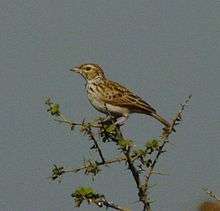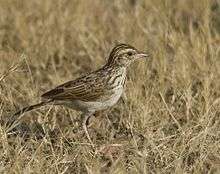Indian bush lark
The Indian bush lark (Mirafra erythroptera) is a species of lark in the family Alaudidae found in South Asia.
| Indian bush lark | |
|---|---|
 | |
| Scientific classification | |
| Kingdom: | Animalia |
| Phylum: | Chordata |
| Class: | Aves |
| Order: | Passeriformes |
| Family: | Alaudidae |
| Genus: | Mirafra |
| Species: | M. erythroptera |
| Binomial name | |
| Mirafra erythroptera Blyth, 1845 | |
Taxonomy and systematics
The alternate names "red-winged lark" and "red-winged bush lark" are more commonly used to describe the red-winged lark (M. hypermetra).[2] Other alternate names of the Indian bush lark are Indian lark, Indian red-winged lark, red-winged singing bushlark and rusty-winged lark.
Description
It is distinguished from Jerdon's bush lark by its shorter bill and legs and longer tail.
The plumage of the Indian bush lark is pale and it has a cheek patch completely bounded by a white supercilium and post-auricular border. The crown and upper-parts are heavily streaked. The pale underparts have large spots on the breast. Most of its wing coverts, tertials and central tail feathers have pale centres. The primary coverts look all brown. The rufous wing bars are diagnostic but care must be taken not to confuse the bird with Jerdon's bush lark in the central Western Ghats and country around where their ranges overlap. Jerdon's bush lark is darker with more rufous on the wings.
It sings from bush tops but does not usually perch on trees or wires. The calls are similar to that of Jerdon's bush lark but are lower and have longer rattling tremolos often falling in pitch.[3]
Distribution and habitat

The Indian bush lark is most commonly found in arid areas. It is found in Pakistan and north-western, central and south-central India.
Behaviour and ecology
The song-flight during the mating season is an amazing spectacle. The bird flutters high over the ground, then holds its wings in an open "V" and "parachutes" down to its perch uttering its song consisting of short tweets and cheeps in three syllables followed by a longer fourth syllable. This combination is repeated till the bird perches again.
References
- BirdLife International (2012). "Mirafra erythroptera". IUCN Red List of Threatened Species. 2012. Retrieved 26 November 2013.CS1 maint: ref=harv (link)
- "Mirafra hypermetra - Avibase". avibase.bsc-eoc.org. Retrieved 2016-11-28.
- P.C. Rasmussen & J.C. Anderton (2005). Birds of South Asia. The Ripley Guide. Lynx Edicions.
- Compilers: Stuart Butchart, Jonathan Ekstrom (2008). "Indian Lark - BirdLife Species Factsheet". Evaluators: Jeremy Bird, Stuart Butchart. BirdLife International. Retrieved May 10, 2009.
